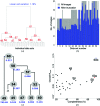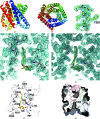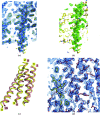Structure determination of an integral membrane protein at room temperature from crystals in situ
- PMID: 26057664
- PMCID: PMC4461203
- DOI: 10.1107/S139900471500423X
Structure determination of an integral membrane protein at room temperature from crystals in situ
Abstract
The structure determination of an integral membrane protein using synchrotron X-ray diffraction data collected at room temperature directly in vapour-diffusion crystallization plates (in situ) is demonstrated. Exposing the crystals in situ eliminates manual sample handling and, since it is performed at room temperature, removes the complication of cryoprotection and potential structural anomalies induced by sample cryocooling. Essential to the method is the ability to limit radiation damage by recording a small amount of data per sample from many samples and subsequently assembling the resulting data sets using specialized software. The validity of this procedure is established by the structure determination of Haemophilus influenza TehA at 2.3 Å resolution. The method presented offers an effective protocol for the fast and efficient determination of membrane-protein structures at room temperature using third-generation synchrotron beamlines.
Keywords: in situ data collection; membrane protein; multiple data sets; synchrotron beamline.
Figures





Comment in
-
Advances in membrane protein crystallography: in situ and in meso data collection.Acta Crystallogr D Biol Crystallogr. 2015 Jun;71(Pt 6):1226-7. doi: 10.1107/S1399004715008317. Epub 2015 May 23. Acta Crystallogr D Biol Crystallogr. 2015. PMID: 26057663 Free PMC article.
References
-
- Adams, P. D. et al. (2010). Acta Cryst. D66, 213–221. - PubMed
-
- Barends, T. R. M., Foucar, L., Botha, S., Doak, R. B., Shoeman, R. L., Nass, K., Koglin, J. E., Williams, G. J., Boutet, S., Messerschmidt, M. & Schlichting, I. (2014). Nature (London), 505, 244–247. - PubMed
-
- Broennimann, C., Eikenberry, E. F., Henrich, B., Horisberger, R., Huelsen, G., Pohl, E., Schmitt, B., Schulze-Briese, C., Suzuki, M., Tomizaki, T., Toyokawa, H. & Wagner, A. (2006). J. Synchrotron Rad. 13, 120–130. - PubMed
-
- Chapman, H. N. et al. (2011). Nature (London), 470, 73–77. - PubMed
Publication types
MeSH terms
Substances
Associated data
- Actions
Grants and funding
LinkOut - more resources
Full Text Sources

